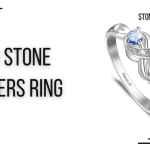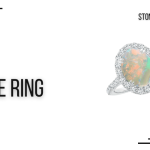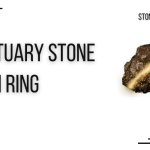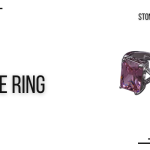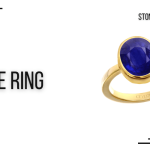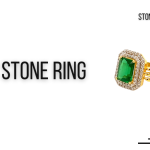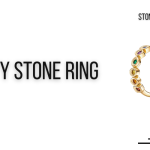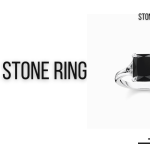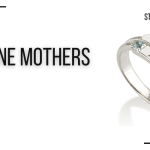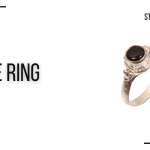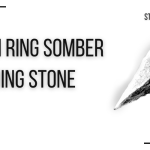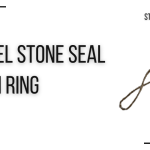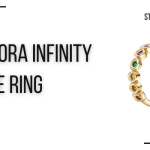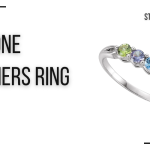Welcome esteemed readers to an exploration into the captivating world of blue stone rings. These exquisite jewelry pieces, reminiscent of clear summer skies or the fathomless ocean depths, carry a charisma unmatched. Bluestone rings are not mere ornaments; instead, they are profound expressions of art and elegance. As they elegantly adorn your finger, they hold within them a universe of beauty reminiscent of Earth’s most enigmatic natural wonders. With an allure that draws the eye and a brilliance that echoes the stars themselves, these rings encapsulate a unique charm. In this exploration, we shall delve into the nuanced intricacies of these remarkable accessories, whose enchanting allure captures the heart at first sight. Please join us on this intriguing journey.
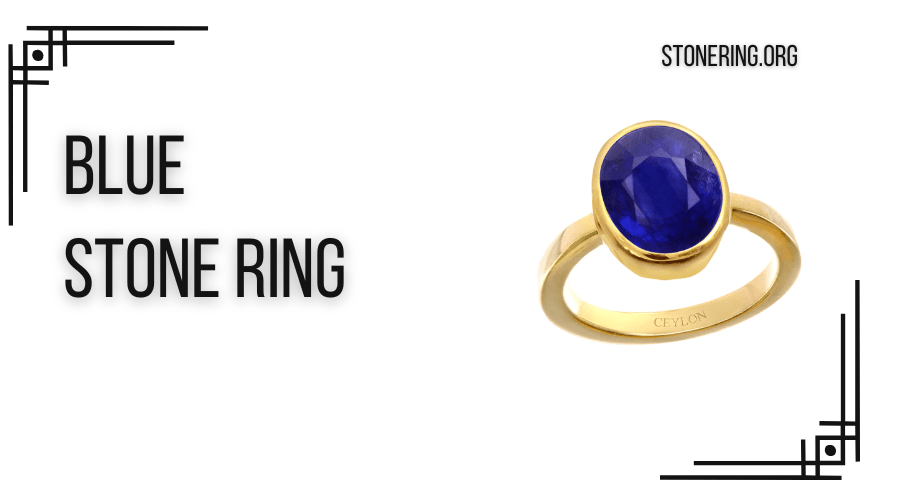
What is a Blue Stone Ring?
A Blue Stone Ring, as the name implies, is a ring featuring a blue gemstone. This gemstone could be of various types, each with unique properties and allure. For instance, sapphires, a prized gemstone second only to diamonds in their hardness, showcase a royal blue that captures the profound depth of the midnight sky. Alternatively, an aquamarine displays a softer, lighter hue, evoking the tranquillity and serenity of a gentle sea. Other famous blue stones include the earthy, rich Turquoise, the stunningly rare blue diamond, and the enigmatic blue topaz. The type of blue stone chosen significantly influences the overall character and appeal of the ring.
These stones are skillfully embedded in various settings, crafted from gold, silver, platinum, or even rose gold. The type of setting and cut of the stone further contribute to the ring’s overall aesthetic, from the classic elegance of a princess cut in a prong setting to the modern sophistication of a cushion cut in a bezel setting. The myriad combinations ensure a blue stone ring for every style and preference, creating a truly personalized piece of jewelry. Moreover, blue stone rings often bear a rich history and cultural significance, with some stones believed to carry certain qualities or powers. Whether you’re seeking a unique fashion statement, a memorable gift, or a meaningful symbol, blue stone rings offer an enchanting blend of natural beauty and artisanal craftsmanship.
The History of Blue Stone Rings the Beginning: Origins and First Civilizations
The saga of the Blue Stone Ring began thousands of years ago, marking its origins in ancient civilizations. Early civilizations used lapis lazuli and other blue stones to fashion ornate rings.
- A Royal Affair
The allure of the Blue Stone Ring extended to the monarchies of the Middle Ages. Royal figures, particularly those in the European kingdoms, wore these rings to symbolize their regal stature. Blue stones like Sapphire were associated with divine favor and wisdom. One of the most iconic historical examples is the St. Edward’s Sapphire, a blue gemstone embedded in the Imperial State Crown of England. The vivid blue of these stones captivated monarchs, signifying their power and divine right to rule.
- Time Travelling
As we journey through time, the prestige and popularity of the Blue Stone Ring never seem to fade. Instead, it transitioned and transformed with the times.
- The Georgian and Victorian Era – Blue stones, particularly sapphires, were a favored choice for betrothal rings. The ‘something blue tradition in weddings today harks back to this era.
- Art Nouveau and Art Deco Periods – Artists and jewelers experimented with different designs and styles. The blue stones were often paired with contrasting colors, like the fiery red rubies or sparkling diamonds, producing innovative, geometric designs.
- Post-World War II to Contemporary Times – The modern period emphasized personal style and meaning. Blue Stone Rings found favor among many with its rich history and aesthetic appeal. The engagement ring of Princess Diana, now worn by Duchess Catherine Middleton, featuring an oval blue sapphire surrounded by diamonds, solidified the timeless appeal of blue stone rings.
The story of the Blue Stone Ring is as multifaceted and vibrant as the gemstones themselves, carrying us through epochs and across civilizations. Each era brought a unique perspective to these rings, shaping them into the treasured pieces we cherish today.
Types of Blue Stones in Rings
- Sapphire Sophistication: The Eternal Charm
The Sapphire is at the pinnacle of blue gemstones in Blue Stone Rings. It’s unmatched sophistication and eternal charm have cemented its position in jewelry enthusiasts’ and connoisseurs’ hearts. Primarily sourced from Sri Lanka, Madagascar, and Australia, Sapphires have been revered since ancient times for their mesmerizing deep blue hue and exceptional durability. It’s the Mohs scale’s second hardest natural mineral, rendering it resilient to scratches and physical damage, an ideal candidate for daily wear rings.
Beyond its physical attributes, Sapphire carries a symbolic significance. It’s often associated with wisdom, royalty, and divine blessings, making it popular for engagement rings and other significant jewelry pieces. Its timeless appeal continues to influence modern jewelry trends, as evident in the well-known Sapphire engagement ring of Duchess Catherine Middleton.
- Turquoise Tales: An Ode to Nature’s Palette
Next, on the journey through blue gemstones, we encounter Turquoise, the jewel that narrates tales as old as civilization. This opaque gemstone ranges from sky blue to greenish-blue and boasts captivating natural patterns, offering an earthy, bohemian appeal to any Blue Stone Ring.
Turquoise holds a special place in several cultures. The ancient Egyptians adorned their Pharaohs, while Native American tribes considered it a holy stone. Its unique aesthetic is often associated with protection and tranquillity, and even today, it lends a distinct touch to various jewelry pieces, from vintage styles to contemporary designs.
- Lapis Lazuli Love: From the Laps of the Gods
Steeped in history and lore is the enchanting Lapis Lazuli. This intensely blue gemstone has been loved and revered since the dawn of civilization. Sourced mainly from Afghanistan, Lapis Lazuli is known for its deep, celestial blue color, often speckled with golden flecks of pyrite, giving it a unique, starry night appearance.
Lapis Lazuli carries an unmistakable signature style in Blue Stone Rings. Its rich blue hue and historical and artistic significance make it a treasured choice for those seeking something more than just a piece of jewelry. From ancient Egyptian scarabs to Renaissance ultramarine paints, Lapis Lazuli’s impact traverses time and utility, culminating in its contemporary use in various jewelry forms.
- Aquamarine Allure: The Sea in a Gemstone
Finally, we arrive at Aquamarine, the sea in a gemstone. Named after the Latin word for seawater, Aquamarine captivates with its range of blue hues, from the palest hint of sky blue to the ocean’s deep blue. This gemstone belongs to the beryl family, the same mineral family as the emerald. An Aquamarine Blue Stone Ring exudes a serene aura reminiscent of calm waters. It’s often cut in various shapes and sizes and prized for clarity. Traditionally, Aquamarine was believed to safeguard sailors and guarantee a safe voyage, and it symbolizes tranquillity, courage, and communication.
Each blue stone brings unique attributes, style, and symbolism to the table, making the world of Blue Stone Rings a rich and fascinating arena to explore. The blue stones’ versatility and variety ensure a perfect piece for every taste, every style, and every occasion.
Symbolism and Meanings of Blue Stone Rings
- Colour Chronicles: What Does Blue Symbolize?
Blue occupies a significant place in the vast spectrum of colors. Its color conjures images of expansive skies and deep, serene oceans. Traditionally, blue symbolizes tranquillity, reliability, wisdom, and truth. It’s considered a calming color, often associated with depth and stability, reflecting a state of serene clarity.
In the context of a Blue Stone Ring, these associations transcend the physical piece, endowing the ring with symbolic resonance. The blue stone could serve as a reminder of the vastness and mystery of the world around us. It could symbolize the wearer’s quest for truth, wisdom, or peace. The universal associations of blue contribute to the Blue Stone Ring’s appeal, providing a deeper connection between the wearer and the piece.
- Ring Reading: Symbolic Meanings of Blue Stone Rings
The allure of the Blue Stone Ring extends beyond the visual. Its symbolism is as diverse and profound as the blue stones’ range.
- Sapphire Rings: The Sapphire, with its royal blue color, has been cherished since antiquity for its symbolic resonance. It’s traditionally associated with wisdom, virtue, and good fortune. In the context of engagement rings, Sapphires signify fidelity and the promise of a lasting relationship.
- Turquoise Rings: Turquoise, the sky stone, is considered a master healer. It symbolizes protection, tranquillity, and balance. A Turquoise Blue Stone Ring can literally and metaphorically represent strength and protection during a journey.
- Lapis Lazuli Rings: Lapis Lazuli, known for its intense blue color, symbolizes honor, royalty, power, and vision. It’s said to stimulate enlightenment and enhance dream work. A Lapis Lazuli Blue Stone Ring can denote a connection with the divine and a desire for truth and understanding.
- Aquamarine Rings: As the stone of the sea, Aquamarine carries the energy of the ocean, symbolizing tranquillity, courage, and communication. An Aquamarine Blue Stone Ring might signify clarity in touch and emotional balance.
The symbolism embedded in Blue Stone Rings enhances their appeal and gives them an added layer of meaning. They are not merely pieces of jewelry, but vessels of expression, imbued with centuries of lore and personal significance. Whether chosen for their visual appeal or symbolic resonance, Blue Stone Rings is a profound connection between history, the natural world, and the individual.
The Making of Blue Stone Rings
- Crafting Marvels: The Journey of a Blue Stone Ring
The journey of crafting a Blue Stone Ring is an intricate blend of art and science, tradition and technology. It begins with sourcing the suitable stone – Sapphire, Turquoise, lapis lazuli, or Aquamarine. Gemologists painstakingly evaluate each potential gemstone for its color, clarity, cut, and carat weight. Once selected, the stone is often cut and polished to enhance its natural beauty and showcase its unique features. But the crafting journey isn’t solely about the stone. The design of the ring itself plays a critical role. Jewelers start with a vision, a sketch that morphs into a design, carefully considering the harmony between the stone and the metal. It’s a delicate balance to ensure that the ring setting complements the gemstone, allowing it to take center stage while providing stability and style.
- Setting the Stone: The Art Behind the Beauty
Setting the gemstone is an intricate part of creating a Blue Stone Ring. It’s an art form requiring a skilled hand and an understanding of the stone’s physical properties. Different settings, such as prong, bezel, flush, and pavé, are used, each with aesthetic and functional benefits.
For instance, a prong setting is designed to hold the stone with small metal prongs, allowing maximum light exposure and showcasing the stone’s brilliance. On the other hand, a bezel setting, where the metal wraps around the stone’s girdle, offers better protection and a unique, modern look. The choice of location influences the ring’s overall look and feel, contributing to its beauty and durability.
- Ensuring Eternity: The Durability of Blue Stone Rings
While the allure of a Blue Stone Ring lies in its visual appeal and symbolic resonance, its longevity depends mainly on its durability. This is where the stone’s hardness and the ring’s choice of metal come into play. Sapphires and other blue gemstones are highly durable, ranking nine on the Mohs hardness scale. This means they can withstand scratches and daily wear and tear without getting damaged. While softer, stones like turquoise and lapis lazuli have an enduring appeal and can last for generations with proper care. The choice of metal for the ring, whether it’s gold, silver, platinum, or palladium, also impacts its durability and aesthetic appeal. From carefully selecting the gemstone to setting it into a beautifully designed ring, making a Blue Stone Ring is a complex journey. It’s a testament to human ingenuity and craftsmanship, transforming the raw bounty of nature into a small, wearable piece of art that tells a unique story.
Conclusion
In conclusion, the saga of the Blue Stone Ring is a testament to human artistry and the mesmerizing beauty of nature. Each ring, with its distinctive blue gemstone, carries a universe of symbolic significance and personal connection. Crafted through meticulous processes honoring the gemstone’s natural allure and the artisan’s vision, these rings epitomize a marriage of nature and craftsmanship. They tell a story that stretches to the individual wearer through time, across cultures and civilizations. Whether chosen for their visual charm, symbolic resonance, or combination, Blue Stone Rings is a timeless celebration of beauty, history, and personal expression. The enduring appeal of these rings lies in their physical beauty and ability to connect us to the larger narrative of human experience.

Harry Son, a luminary in the stone ring industry, blends passion with craftsmanship to create timeless pieces. With an eye for detail and dedication to quality, Harry shares his expertise and unique design perspectives. Through insightful articles, he guides readers on a journey to discover the allure and significance of stone-adorned rings, offering a glimpse into the world of exquisite jewelry craftsmanship.

